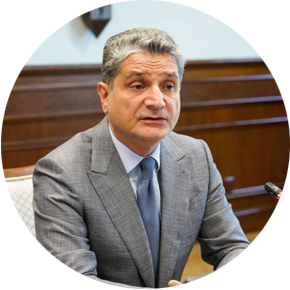The Ministry of Education, Science, Culture and Sport of Armenia has launched the revision of national and subject norms of general education.
A group of local and foreign experts will prepare the report establishing the school subjects, grading system, teaching methods, main curriculum, and the knowledge that students must possess by the time they graduate.
Mediamax has talked with international education and publishing consultant Andy Smart, who is involved in the revision of norms and standards.
Are you familiar with Armenia’s education system? What problems do you see in it?
I haven’t had the chance to study the Armenian education system. I just made a short trip to Armenia in the end of May and I hope to visit more times this and next year. Up till now, all my information is second-hand, it is what other people told me, so I would want to make my own judgment.
Experts say Armenian textbooks provide fewer opportunities for critical thinking. How do you think Armenia can develop analytical approach among students?
There is tension between some of the functions of the textbook and the idea of critical thinking, because in many schools and education systems the textbook has a big authority, a huge status. It is a source of all of authority and statements about values, identity, history, so the idea of applying critical thinking is sometimes a challenge to the ideas on authority. However it is always possible to find a way to encourage critical thinking. It will depend on the subject matter, the education level, but I think even for younger children it is very possible to have interesting approaches, whether it’s mathematics, science or language studies, which develop critical thinking.
In mathematics, for example, if you’re talking about shapes, one way of approaching that is to set a definition of shape and present examples of shapes. On the other hand, you can give an opportunity to children to explore the idea of shape. That is something which, if the teacher feels empowered to lead that discussion and the children feel empowered to express their opinion, can be a very liberating and fruitful critical thinking approach. With the older students in the secondary schools, we can talk more about different interpretations of historical events and have a much more in-depth critical analysis of literary texts. It really is possible to do it at all levels, ages and subjects.
In Armenia, parents often raise the issue of the weight of textbooks the child has to carry to the school. There are countries who have been trying to use e-textbooks. What is the international experience in this regard?
This is a huge issue and countries have been wrestling with it for quite a long time already. I would say the starting point for thinking of how to use digital resources in classroom is to think about the kind of pedagogy that you are supporting with those resources. The problem comes when policy makers think that digital resources will solve other problems. I don’t think you will find a solution in e-books, digital resources.
There are countries that have experimented with different approaches. If you look at recent history of improving education in South Korea, it was supposed to be the pioneer of moving entirely to electronic textbooks. It was widely reported, but it didn’t happen because of the concerns about the other aspects and factors involved in e-textbooks regarding children’s health and issues of pedagogy. The Korean system is still a mixed system that uses printed and digital materials. That is the situation in many countries. As for the kind of digital resources, there are multiple of them, and in my country (England – Mediamax.am) the digital learning resources in classroom are not electronic textbooks. It is the interactive white board, the smart board.
One thing I would say is that some of the research into digital textbooks is based on a different way of thinking about learning. It’s the idea of individual students working on their own with a laptop and going through a personalized learning program. That is a completely different kind of education and pedagogy from what most teachers, systems are used to. Actually, it is not what most experts on pedagogy would support as a main approach to teaching or learning. It’s a supplementary activity, when students are able to go and spend some time developing particular skills, and the results from that experience can be useful to the teacher to show where the student’s strengths and weaknesses are. That’s an individual approach to learning, which is not what happens in most schools most of the time. Schools are about students learning together guided by teacher rather than individually, cut-off from other learners and to some extent cut-off from the teacher.
Armenia is coming closer to inclusive education, but there are persisting problems with textbooks for children, for example, with visual issues. What solution do you see there?
This is not an area I specialize in. My thoughts are that it is part of a bigger challenge of supporting students with learning difficulties. If they are non-cognitive difficulties, to some extent it’s the question of resources. If the student is blind or partially blind, to some extent you can have the same teaching and learning environment, but using adapted material. In the past that adaptation used to be large print for students with poor eyesight. Now, if it’s a digital book, it could have corresponding features. It is part of a bigger issue, of how education is organized for children with special needs, because that requires special training for teachers, special facilities in the school, extra financial resources as well. So, to some extent textbooks can help to overcome some of the learning difficulties, but if it’s about cognitive difficulties, then it is more about the teacher’s skill and training.
There have been some examples: in England, publishers published two different editions of a textbook series, a higher edition and a lower one, and schools would have the choice of which edition they order. It’s the same content, the page has the same illustrations and topics, but the level of challenge is different, so the cognitive demands are different. It creates other problems because teachers or schools in this situation are making choices about the categories that their students fit into. In a system that should provide an equal opportunity for education to all children, there will always be controversial issues around categorizing students in that way. Some schools might categorize students in terms of having faster and slower classes, some schools might have a faster group and a slower group within the same class. These are controversial issues and there is a lot of research about the difference of opinion about the social effects of this kind of categorization.
How often do textbooks need to be reviewed and republished, especially if it demands large funds?
This is obviously linked to the curriculum cycle. The government decides what the best timeframe for reviewing and revising the curriculum is. In some countries it’s a regular cycle, like an election cycle: every 4 or 5 years you have a new curriculum. In other countries, it is less regular. The curriculum cycle affects the textbook cycle. If it’s the publishers that choose when to republish textbooks rather government publishing textbooks, it is possible that the publishers make their own decisions about updating their own textbook, because it is a market-based, commercial decision if they make changes or updates to the textbooks and they become more attractive to schools.
This does vary from country to country and subject to subject. If it’s a mathematics, language and literature textbook, there won’t be many changes in what the curriculum proposes to teach. Unless there is political pressure to read this kind of author rather than that kind of author, which happens, then the curriculum can be quite stable, it won’t change that much. If you’re talking about sociology or other things that have much more connection to the contemporary society, then the textbooks should be frequently updated because if the student sees the textbook is out of date, that undermines the authority of the textbook.
We have internet and diversity of information sources, and it makes our textbooks less competitive. How can we change our teaching methods and the content of textbooks to make them more interesting for the new generation?
For me, this is about the system as a whole, not just about what kind of resources you use. It’s about how you use your resources. Even in school systems with good infrastructure, good internet bandwidth and so on teachers may use these resources in quite different ways. Some of them might have more open-ended, hands-off approach, where students are free to explore internet to carry out some on-the-spot research in the classroom, in groups or individually. Other teachers would take a very different view: they would be very strict and limit the students’ access. Some schools have strict rules about the use of mobile phone in the classroom.
Sometimes it is a school policy and sometimes the teacher’s own policy about how they manage the classroom. For some teachers mobile phone is a resource and for others it is a distraction. Some are able to balance the two demands and they may have particular moments in the lesson when they say: “I want you to do this on the mobile phone.” It can be for reporting answers, for example. It’s very controlled use of mobile phone in the classroom, and that, of course, depends on everybody having a mobile phone in the class.
There are potentially many more ways of using resources if you have good access to them and if you have different devices in classroom, but I think the place to start is by looking at making textbooks more interesting. It can be a traditional printed textbook, but with a more engaging pedagogy and supported by professional development for teachers so that textbooks can be used in the ways they aren’t intended to be used and there is more interaction between teacher and student. People often talk about digital resources as being interactive. The first point of interaction is between the student and the teacher. If that’s interactive, then you can bring in other ways of interacting with other resources like internet and other digital material.
Lusine Gharibyan talked to Andy Smart





















Comments
Dear visitors, You can place your opinion on the material using your Facebook account. Please, be polite and follow our simple rules: you are not allowed to make off - topic comments, place advertisements, use abusive and filthy language. The editorial staff reserves the right to moderate and delete comments in case of breach of the rules.